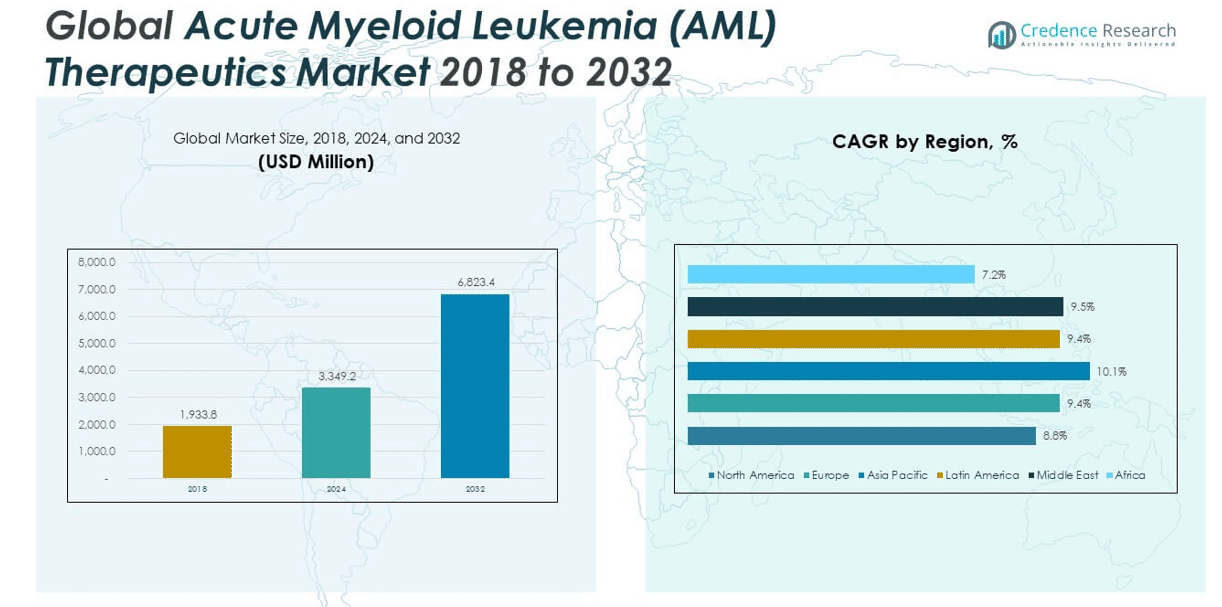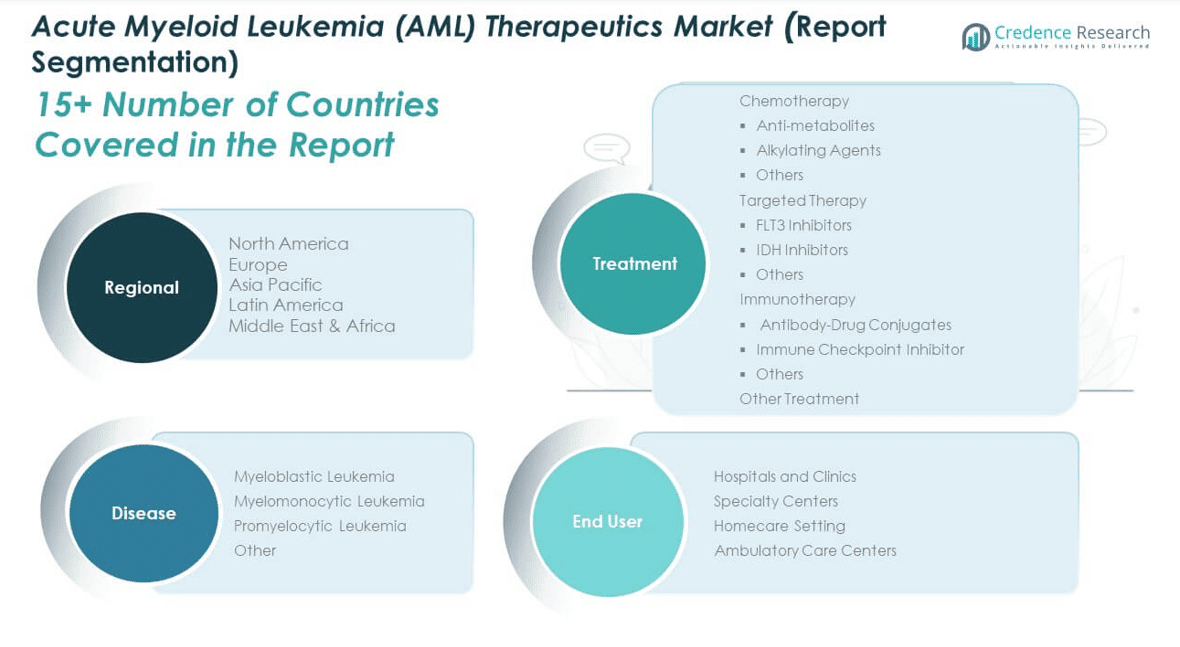CHAPTER NO. 1 : GENESIS OF THE MARKET
1.1 Market Prelude – Introduction & Scope
1.2 The Big Picture – Objectives & Vision
1.3 Strategic Edge – Unique Value Proposition
1.4 Stakeholder Compass – Key Beneficiaries
CHAPTER NO. 2 : EXECUTIVE LENS
2.1 Pulse of the Industry – Market Snapshot
2.2 Growth Arc – Revenue Projections (USD Million)
2.3. Premium Insights – Based on Primary Interviews
CHAPTER NO. 3 : ACUTE MYELOID LEUKEMIA (AML) THERAPEUTICS MARKET FORCES & INDUSTRY PULSE
3.1 Foundations of Change – Market Overview
3.2 Catalysts of Expansion – Key Market Drivers
3.2.1 Momentum Boosters – Growth Triggers
3.2.2 Innovation Fuel – Disruptive Technologies
3.3 Headwinds & Crosswinds – Market Restraints
3.3.1 Regulatory Tides – Compliance Challenges
3.3.2 Economic Frictions – Inflationary Pressures
3.4 Untapped Horizons – Growth Potential & Opportunities
3.5 Strategic Navigation – Industry Frameworks
3.5.1 Market Equilibrium – Porter’s Five Forces
3.5.2 Ecosystem Dynamics – Value Chain Analysis
3.5.3 Macro Forces – PESTEL Breakdown
CHAPTER NO. 4 : KEY INVESTMENT EPICENTER
4.1 Regional Goldmines – High-Growth Geographies
4.2 Treatment Frontiers – Lucrative Treatment Categories
4.3 End User Sweet Spots – Emerging Demand Segments
CHAPTER NO. 5: REVENUE TRAJECTORY & WEALTH MAPPING
5.1 Momentum Metrics – Forecast & Growth Curves
5.2 Regional Revenue Footprint – Market Share Insights
5.3 Segmental Wealth Flow – Treatment, Disease, and End User Revenue
CHAPTER NO. 6 : TRADE & COMMERCE ANALYSIS
6.1. Import Analysis By Region
6.1.1. Global Acute Myeloid Leukemia (AML) Therapeutics Market Import Revenue By Region
6.2. Export Analysis By Region
6.2.1. Global Acute Myeloid Leukemia (AML) Therapeutics Market Export Revenue By Region
CHAPTER NO. 7 : COMPETITION ANALYSIS
7.1. Company Market Share Analysis
7.1.1. Global Acute Myeloid Leukemia (AML) Therapeutics Market: Company Market Share
7.2. Global Acute Myeloid Leukemia (AML) Therapeutics Market Company Revenue Market Share
7.3. Strategic Developments
7.3.1. Acquisitions & Mergers
7.3.2. New Treatment Launch
7.3.3. Regional Expansion
7.4. Competitive Dashboard
7.5. Company Assessment Metrics, 2024
CHAPTER NO. 8 : ACUTE MYELOID LEUKEMIA (AML) THERAPEUTICS MARKET – BY TREATMENT SEGMENT ANALYSIS
8.1. Acute Myeloid Leukemia (AML) Therapeutics Market Overview By Treatment Segment
8.1.1. Acute Myeloid Leukemia (AML) Therapeutics Market Revenue Share By Treatment
8.2. Chemotherapy
8.2.1 Anti-metabolites
8.2.2. Alkylating Agents
8.2.3 Others
8.3. Targeted Therapy
8.3.1. FLT3 Inhibitors
8.3.2. IDH Inhibitors
8.3.3. Others
8.4. Immunotherapy
8.4.1. Antibody-drug Conjugates
8.4.2. Immune Checkpoint Inhibitor
8.4.3. Others
8.5. Other Treatment
CHAPTER NO. 9 : ACUTE MYELOID LEUKEMIA (AML) THERAPEUTICS MARKET – BY DISEASE SEGMENT ANALYSIS
9.1. Acute Myeloid Leukemia (AML) Therapeutics Market Overview By Disease Segment
9.1.1. Acute Myeloid Leukemia (AML) Therapeutics Market Revenue Share By Disease
9.2. Myeloblastic Leukemia
9.3. Myelomonocytic Leukemia
9.4. Promyelocytic Leukemia
9.5. Other
CHAPTER NO. 10 : ACUTE MYELOID LEUKEMIA (AML) THERAPEUTICS MARKET – BY END USER SEGMENT ANALYSIS
10.1. Acute Myeloid Leukemia (AML) Therapeutics Market Overview By End User Segment
10.1.1. Acute Myeloid Leukemia (AML) Therapeutics Market Revenue Share By End User
10.2. Hospitals and Clinics
10.3. Specialty Centers
10.4. Homecare Setting
10.5. Ambulatory Care Centers
CHAPTER NO. 11 : ACUTE MYELOID LEUKEMIA (AML) THERAPEUTICS MARKET – REGIONAL ANALYSIS
11.1. Acute Myeloid Leukemia (AML) Therapeutics Market Overview By Region Segment
11.1.1. Global Acute Myeloid Leukemia (AML) Therapeutics Market Revenue Share By Region
10.1.2. Regions
11.1.3. Global Acute Myeloid Leukemia (AML) Therapeutics Market Revenue By Region
11.1.4. Treatment
11.1.5. Global Acute Myeloid Leukemia (AML) Therapeutics Market Revenue By Treatment
11.1.6. Disease
11.1.7. Global Acute Myeloid Leukemia (AML) Therapeutics Market Revenue By Disease
11.1.8. End User
11.1.9. Global Acute Myeloid Leukemia (AML) Therapeutics Market Revenue By End User
CHAPTER NO. 12 : NORTH AMERICA ACUTE MYELOID LEUKEMIA (AML) THERAPEUTICS MARKET – COUNTRY ANALYSIS
12.1. North America Acute Myeloid Leukemia (AML) Therapeutics Market Overview By Country Segment
12.1.1. North America Acute Myeloid Leukemia (AML) Therapeutics Market Revenue Share By Region
12.2. North America
12.2.1. North America Acute Myeloid Leukemia (AML) Therapeutics Market Revenue By Country
12.2.2. Treatment
12.2.3. North America Acute Myeloid Leukemia (AML) Therapeutics Market Revenue By Treatment
12.2.4. Disease
12.2.5. North America Acute Myeloid Leukemia (AML) Therapeutics Market Revenue By Disease
12.2.6. End User
12.2.7. North America Acute Myeloid Leukemia (AML) Therapeutics Market Revenue By End User
12.3. U.S.
12.4. Canada
12.5. Mexico
CHAPTER NO. 13 : EUROPE ACUTE MYELOID LEUKEMIA (AML) THERAPEUTICS MARKET – COUNTRY ANALYSIS
13.1. Europe Acute Myeloid Leukemia (AML) Therapeutics Market Overview By Country Segment
13.1.1. Europe Acute Myeloid Leukemia (AML) Therapeutics Market Revenue Share By Region
13.2. Europe
13.2.1. Europe Acute Myeloid Leukemia (AML) Therapeutics Market Revenue By Country
13.2.2. Treatment
13.2.3. Europe Acute Myeloid Leukemia (AML) Therapeutics Market Revenue By Treatment
13.2.4. Disease
13.2.5. Europe Acute Myeloid Leukemia (AML) Therapeutics Market Revenue By Disease
13.2.6. End User
13.2.7. Europe Acute Myeloid Leukemia (AML) Therapeutics Market Revenue By End User
13.3. UK
13.4. France
13.5. Germany
13.6. Italy
13.7. Spain
13.8. Russia
13.9. Rest of Europe
CHAPTER NO. 14 : ASIA PACIFIC ACUTE MYELOID LEUKEMIA (AML) THERAPEUTICS MARKET – COUNTRY ANALYSIS
14.1. Asia Pacific Acute Myeloid Leukemia (AML) Therapeutics Market Overview By Country Segment
14.1.1. Asia Pacific Acute Myeloid Leukemia (AML) Therapeutics Market Revenue Share By Region
14.2. Asia Pacific
14.2.1. Asia Pacific Acute Myeloid Leukemia (AML) Therapeutics Market Revenue By Country
14.2.2. Treatment
14.2.3. Asia Pacific Acute Myeloid Leukemia (AML) Therapeutics Market Revenue By Treatment
14.2.4. Disease
14.2.5. Asia Pacific Acute Myeloid Leukemia (AML) Therapeutics Market Revenue By Disease
14.2.6. End User
14.2.7. Asia Pacific Acute Myeloid Leukemia (AML) Therapeutics Market Revenue By End User
14.3. China
14.4. Japan
14.5. South Korea
14.6. India
14.7. Australia
14.8. Southeast Asia
14.9. Rest of Asia Pacific
CHAPTER NO. 15 : LATIN AMERICA ACUTE MYELOID LEUKEMIA (AML) THERAPEUTICS MARKET – COUNTRY ANALYSIS
15.1. Latin America Acute Myeloid Leukemia (AML) Therapeutics Market Overview By Country Segment
15.1.1. Latin America Acute Myeloid Leukemia (AML) Therapeutics Market Revenue Share By Region
15.2. Latin America
15.2.1. Latin America Acute Myeloid Leukemia (AML) Therapeutics Market Revenue By Country
15.2.2. Treatment
15.2.3. Latin America Acute Myeloid Leukemia (AML) Therapeutics Market Revenue By Treatment
15.2.4. Disease
15.2.5. Latin America Acute Myeloid Leukemia (AML) Therapeutics Market Revenue By Disease
15.2.6. End User
15.2.7. Latin America Acute Myeloid Leukemia (AML) Therapeutics Market Revenue By End User
15.3. Brazil
15.4. Argentina
15.5. Rest of Latin America
CHAPTER NO. 16 : MIDDLE EAST ACUTE MYELOID LEUKEMIA (AML) THERAPEUTICS MARKET – COUNTRY ANALYSIS
16.1. Middle East Acute Myeloid Leukemia (AML) Therapeutics Market Overview By Country Segment
16.1.1. Middle East Acute Myeloid Leukemia (AML) Therapeutics Market Revenue Share By Region
16.2. Middle East
16.2.1. Middle East Acute Myeloid Leukemia (AML) Therapeutics Market Revenue By Country
16.2.2. Treatment
16.2.3. Middle East Acute Myeloid Leukemia (AML) Therapeutics Market Revenue By Treatment
16.2.4. Disease
16.2.5. Middle East Acute Myeloid Leukemia (AML) Therapeutics Market Revenue By Disease
16.2.6. End User
16.2.7. Middle East Acute Myeloid Leukemia (AML) Therapeutics Market Revenue By End User
16.3. GCC Countries
16.4. Israel
16.5. Turkey
16.6. Rest of Middle East
CHAPTER NO. 17 : AFRICA ACUTE MYELOID LEUKEMIA (AML) THERAPEUTICS MARKET – COUNTRY ANALYSIS
17.1. Africa Acute Myeloid Leukemia (AML) Therapeutics Market Overview By Country Segment
17.1.1. Africa Acute Myeloid Leukemia (AML) Therapeutics Market Revenue Share By Region
17.2. Africa
17.2.1. Africa Acute Myeloid Leukemia (AML) Therapeutics Market Revenue By Country
17.2.2. Treatment
17.2.3. Africa Acute Myeloid Leukemia (AML) Therapeutics Market Revenue By Treatment
17.2.4. Disease
17.2.5. Africa Acute Myeloid Leukemia (AML) Therapeutics Market Revenue By Disease
17.2.6. End User
17.2.7. Africa Acute Myeloid Leukemia (AML) Therapeutics Market Revenue By End User
17.3. South Africa
17.4. Egypt
17.5. Rest of Africa
CHAPTER NO. 18 : COMPANY PROFILES
18.1. Boehringer Ingelheim GmbH
18.1.1. Company Overview
18.1.2. Treatment Portfolio
18.1.3. Financial Overview
18.1.4. Recent Developments
18.1.5. Growth Strategy
18.1.6. SWOT Analysis
18.2. Abbott
18.3. Bristol Myers Squibb Company
18.4. Celegene Corporation
18.5. Eli Lilly and Company
18.6. Jazz Pharmaceuticals, Inc.
18.7. Novartis AG
18.8. Pfizer Inc.
18.9. Eisai Co. Ltd.
18.10. Other Key Players









